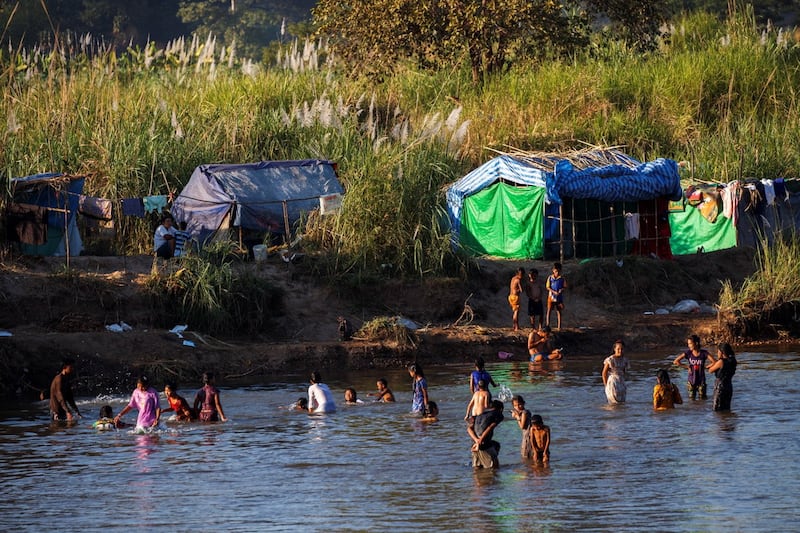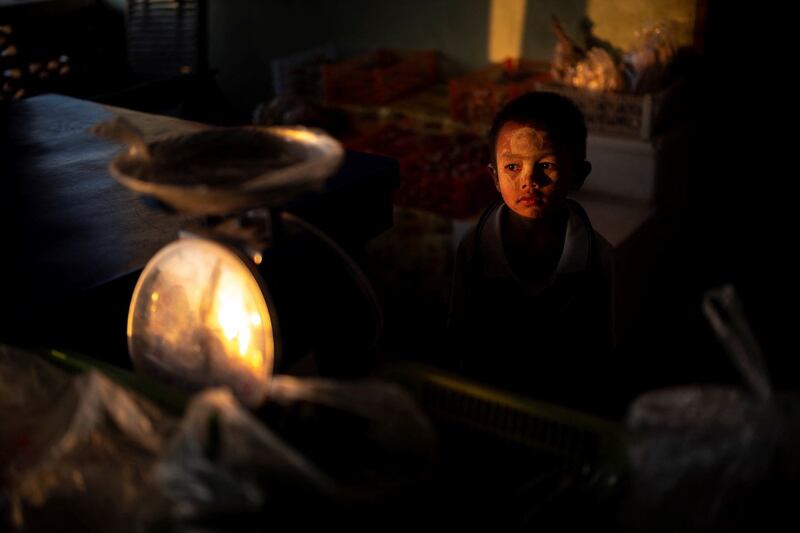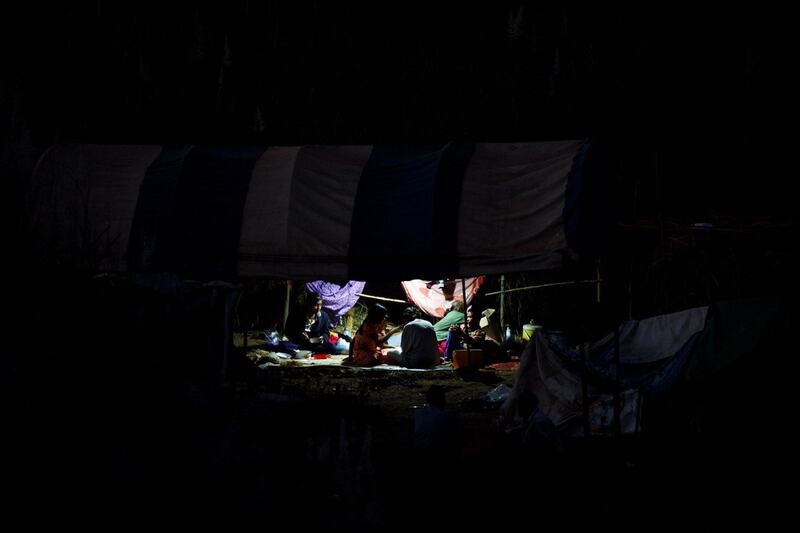More than 20,000 people who fled fighting between the military and anti-junta forces in two townships in Myanmar’s Kayin state remain displaced as clashes continue in the area, residents and aid groups said Wednesday, creating a humanitarian crisis that is spilling across the border into neighboring Thailand.
Burmese Aid for Refugees spokesman Ye Min told RFA’s Myanmar Service that the refugees originated from the townships of Myawaddy and Kawkareik, where for nearly a month government troops have battled a combined group of prodemocracy People’s Defense Force militiamen and fighters with the Karen National Liberation Army — the armed wing of the Karen National Union (KNU) political group.
“Currently, there are tens of thousands of people who have fled the fighting in Myawaddy township due to the intensity of the Lay Kay Kaw clashes [beginning on Dec. 15],” he said.
“There are thousands more in Kawkareik township and in Mutraw district in KNU [controlled] territory — the refugees have not yet been able to return home. We estimate this based on the location of the villages and the population. The number of refugees could be even more than 20,000.”
Most refugees have fled to makeshift camps along the banks of the Thaung Yin (Moei) River and into neighboring Thailand, with more crossing the border every day. Those in Thailand told RFA that Thai authorities have allowed them to stay and accept relief items from donors. An estimated 4,700 refugees from Myanmar are sheltering in Thailand, according to the Thai government.
Aid workers told RFA on Thursday that the Thai government had sheltered “more than 3,000” refugees from Myanmar at a cattle ranch and nearby buildings in Mae Sot’s Mae Kot Kin village in Tak province, due to the continued fighting across the border in and around Lay Kaw Kaw.
They said that during the third week of December, about 6,000 refugees from Myanmar fled across the border, after which some returned, and others resettled with friends and family in Thailand. A tiny fraction of the refugees was urgently resettled in third countries, as well.
Ye Min, of the Aid Alliance Committee relief organization, said the number of Myanmar refugees in Thailand fluctuates between 3,000 and 5,000 a day, as some are moving back to Myanmar or Thailand depending on fighting situations. He said some refugees were living in makeshift tents along the banks of the river on the Myanmar side of the border to monitor the intensity of the fighting.
“There are about seven or eight groups with their own population of 100-200 on the Myanmar side of the river,” he said.
“If the situation gets worse, they can easily run to the other side and stay by the river. If the situation is better, they can go back to their villages. The sides are in proximity. The refugees live that way, tolerating the situation.”

Clashes ongoing
Meanwhile, fighting continues in Kayin state, with residents and aid groups reporting heavy shelling on Wednesday morning in Ploo village near Lay Kay Kaw and a military airstrike in Kawkareik township earlier this week.
A refugee inside Thailand told RFA on condition of anonymity, citing fear of reprisal, that most people who have tried to return home come back to the border amid the ongoing clashes.
“[Pro-military Karen leaders] came to the refugee camps and tried to persuade people to return. They said people could return home, but even people who left the Thai side have come back,” she said.
“It is not safe to go back because fighting could erupt at any time.”
She said the refugees are living on donor-supplied food and aid and are concerned about their long-term survival. Among those sheltering along the riverbank on the Myanmar side are the elderly, newborn babies and the sick, she said, adding that there is a shortage of medicine in the area and no access to medical care.

Junta claims
North along the Thai frontier, the capital of Kayin's neighboring Kayah (Karenni) state, Loikaw, has seen two-thirds of its population of 100,000 flee military attacks on anti-junta forces in the region, a local officials said.
Loikaw had seen its population swell in recent weeks with some 30,000 war refugees seek shelter from raids. But on Jan. 6, troops loyal to the military regime fired heavy weapons and sent tanks and helicopters into Loikaw to battle joint forces of the Karenni Army and the People’s Defense Force and Karenni National Defense Force (KNDF), sparking another exodus.
As many as 60,000 civilians from Loikaw have fled to areas along southern Shan State in past five days after the military launched air raids on local militias on Wednesday, local officials said.
The junta said it attacked forces in Loikaw with heavy weapons after they tried to attack and open a prison. Loikaw residents told RFA that only 10 percent of the city’s population remains in town and many are urgently preparing to flee.
The junta has arrested more than 8,560 civilians and killed 1,463 since its Feb. 1 coup, mostly during non-violent protests of the coup, according to the Bangkok-based Assistance Association for Political Prisoners. Following the takeover, the military launched offensives in several of the country’s remote border regions, where residents have reported various human rights abuses perpetrated by government troops against civilians.
When asked whether authorities intend to resettle the refugees from Kayin who are sheltering along the border with Thailand, junta Deputy Information Minister Zaw Min Tun said efforts are “underway.”
“In the case of Lay Kay Kaw, or wherever they may be, our policy is to ensure that [refugees] can be resettled in their original homes,” he said.
“We called them back for resettlement within two or three days after the fighting. We are always working to resettle refugees.”
However, a People’s Defense Force member who is fighting alongside the Karen National Liberation Army in Kawkareik township told RFA that the fighting has not stopped, and that the junta is still targeting the area with airstrikes.
“There have been two airstrikes in Kawkareik in recent days. They were using helicopter gunships,” he said.
“It was a bit quiet yesterday and today but on the Lay Kay Kaw side, there was artillery fire this morning fired towards Ploo. On the Lay Kay Kaw side, refugees have been running from place to place due to heavy artillery fire. They can’t stay in any one place and are on the move at all times.”

Refugees at risk
A statement issued on Thursday by the United Nations Office for the Coordination of Humanitarian Affairs said that in southeast Myanmar, at least 654 houses and other civilian properties — including churches and schools — have been destroyed or burnt down since May. It said that as of Jan. 3, some 162,000 people remained displaced from Kayin and Kayah states since fleeing their homes.
Those displaced by the recent fighting join more than 500,000 refugees from decades of conflict between the military and ethnic armed groups who were already counted as displaced at the end of 2020, according to the Internal Displacement Monitoring Center, a Norwegian NGO.
Reported by RFA’s Myanmar Service. Translated by Khin Maung Nyane. Written in English by Joshua Lipes.
